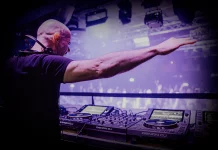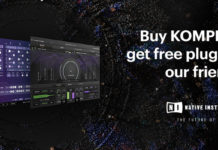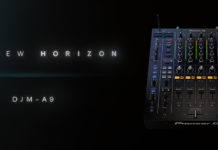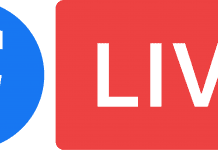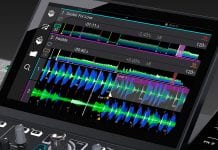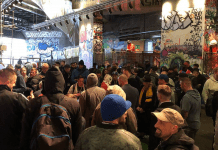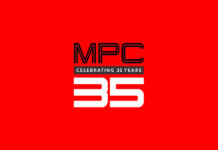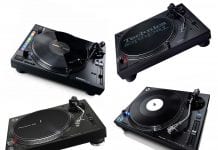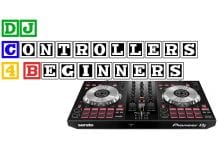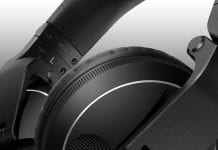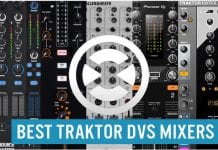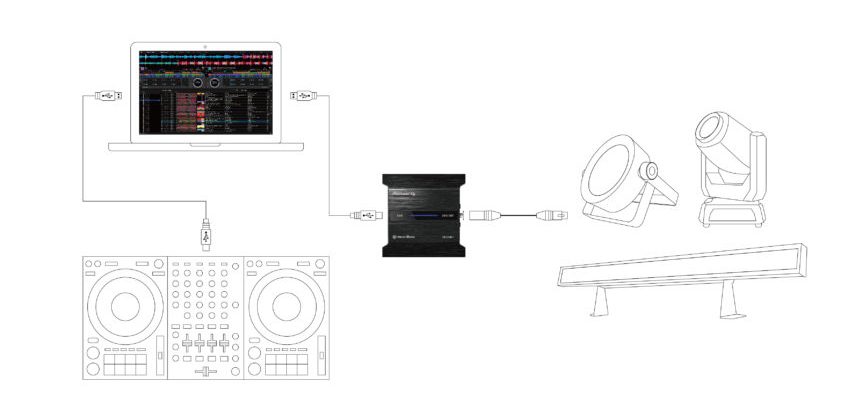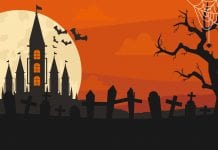Pioneer DJ’s RB-DMX1 and Rekordbox Lighting – 2018’s ultimate sleeper product!
A few months ago, Pioneer DJ released the RB-DMX1 DMX interface. This little box combined with a new add-on “lighting” for the company’s Rekordbox DJ software, to deliver a light show experience that is without rival. The crazy thing is you’ve probably never heard of Rekordbox Lighting Mode and the RB-DMX1. You’re even less likely to have seen the product in action!
Rekordbox DJ Lighting in Action:
Why has everybody slept on the product then? Well it’s not been very well marketed. For those who have bought the RB-DMX1, and don’t have the experience of Check out our guide to DMX Lighting to set the software up, the included manual is useless. Combine this with the lack of online support, and it’s likely many early adopters will be returning the kit to retailers.
Here at Westend DJ, we only discovered the true potential of Rekordbox Lighting mode when we were getting set up for the NADJ London sessions which we hosted on July 16th. We’d lined up a stack of American DJ demo fixtures, and took the plunge by connecting the lot to the RB-DMX1 to see what Rekordbox Lighting was capable of. It took us a few hours to get the best out of the Rekordbox Lighting system. Once we had it hooked up and firing on all cylinders we were quite literally blown away by the results.
As we mentioned earlier, our first setup wasn’t the easiest thing we’ve ever done so here’s what we’ve learned.
First Steps:
First up, you’ll need to connect the RB-DMX1 to your lights and the laptop, this is straight forward enough. Once everything is connected, switch on your lights. It’s time to set the DMX addresses and the type of fixture.
^An example of a typical lighting setup with the RB-DMX1.
Rekordbox Lighting uses the Atlabase database of lighting fixtures. This is updated regularly, if your fixture isn’t included you can request an addition over at the Pioneer DJ forums. With over 13,000 units already included the likelihood you’ll need to do this decreases every day.
So, if for example you want to add a American DJ Vizi Beam RXONE to your rig, simply type the fixture name into the search box (see below) and select one of the profiles from the available list – many lighting units have more than one profile, often there is a simple profile that controls less of the features and uses less channels of DMX as a result.
For our needs we chose the 17-channel profile for the RXONE. We then dragged the channel block up into position one. This has assigned our first RXONE to DMX address one. We now need to set the light up to 17 channel-mode. At the same time we set the DMX address as one so that we’re correctly configured. We repeat this process for the next RXONE. Dragging the unit to DMX address 18. This is the next available as the RXONE we added first up has used 17 channels of DM. As before, we set the fixture to the same DMX address and 17-channel mode.
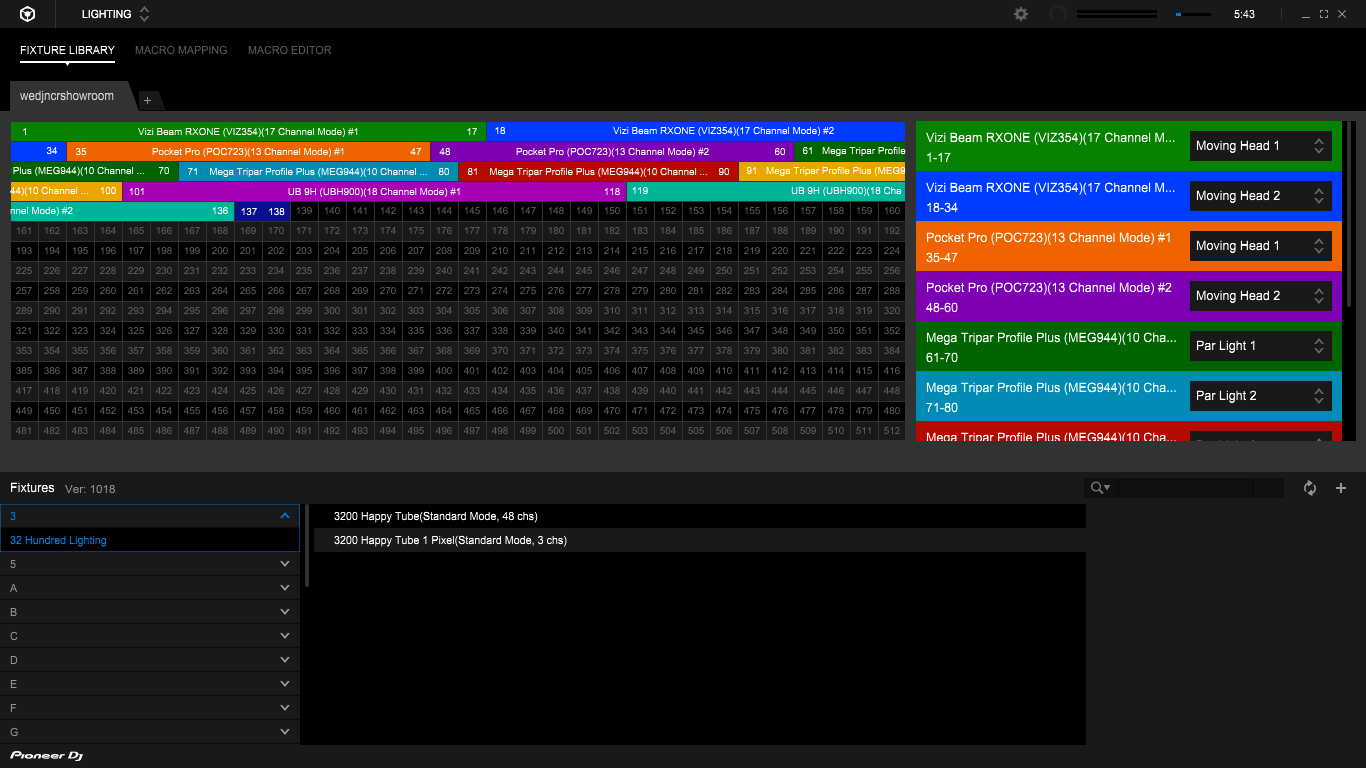 ^The Rekordbox Lighting fixture assignment window, this is where you’ll configure addresses and channel modes for your lights.
^The Rekordbox Lighting fixture assignment window, this is where you’ll configure addresses and channel modes for your lights.
You’ll need to repeat this process for the lights you wish to add, we added an additional set of moving heads, two American DJ Pocket Pro, and four American DJ Mega Tri Par Profile Plus and then selected the fixture types as Moving head 1,2,3 and 4 for the movers and Par Cans 1,2,3 and 4 for the Tri Pars – this was where we made our first couple of mistakes but more on that in a moment…
Step two
Analysis of your tracks using “Phrase Analysis” is the next essentially step to lightshow perfection – Rekordbox very cleverly analyses the structure of the tracks in your collection and assigns them different “phrases” ranging from “intro”, “verse”, “chorus” etc with variations of these. Rekordbox then chooses from 160 pre-programmed light shows dependant on the intensity of the phrases it has analysed and syncs these shows to your tracks.
Simple, well in fact while it is simple it’s absolute bloody genius! You see with sound to light mode on most lights, if you can set your mic sensitivity correctly, you’ll get a light show that reacts to the loudest transients in your tracks. If you’ve invested in great lighting units, the on-board system will recognise a break down and will react accordingly. So, for moving heads it might sweep slowly while the music builds. Previously if you wanted anything more than this you either bought a DMX controller, or you paid an expert a lot of money to come in and either do this for you or operate a serious lighting desk.
Rekordbox lighting removes all of the above headache, and yet it does more!
The “phrase analysis” is actually picking up nuances within the music and syncing the light shows to the vocals or other key elements within the track – in the build-up in Michael Jackson’s “Billie Jean” I noticed the show syncing to the lyrics in key places – at first I thought this was just down to the time signature of the track but closer inspection of the macro revealed the algorithm was snapping the light show to the vocals and it’s not the only track I’ve seen this on.
Here’s a light show sync’d to Duck Sauce’s “Anyway”:
You might be thinking, well that’s all very impressive but how intelligent is the analysis – what does it do if it comes across a bridge or a section of build up? Well Rekordbox understands these sections of music as well and will sync the lightshow accordingly adding in strobed build ups, black outs and more as required.
At this point you might be thinking, does this system have any limitations? Well yes it does I’m afraid…
Step three – setting up your lights correctly
Hang about, we’ve already done this haven’t we – well yes and no. Something we learned early on in the setup of our system here at Westend DJ, was that the pre-programmed shows make use of a number of fixtures. If you don’t have that type of fixture you’ll be literally “in the dark” for certain sections of your track – allow me to explain.
In some of the intros of the first few tracks we tested we were literally stood in the dark. This didn’t seem right as the scene indicator below the track waveform seemed to indicate that something should be happening. A quick right click on the scene showed what appeared to be a wash of colour? That left us thinking that this is strange, we have par cans hooked up and working in busier sections, but these aren’t washing us with light so what’s going wrong? Well it turns out that each of the scenes make use of different fixture types. If the expected fixture isn’t present then, despite the instruction being sent by the software, you’ll be left without light.
We added a pair of American DJ Ultra Bar 9Hs to our rig, set these to the par bar setting and immediately experienced a wash of colour that also synced in with the pars at other points creating an impressive effect. What we realised at this point is that if you don’t have enough fixtures you might not get quite the effect you need, but you can do one of two things at this point – buy more lights (which we’ll happily help you to do) to cover the minimum requirements (more on this in a moment) or cheat (which we’ll also happily help you with).
We’ve found that the minimum required lighting set up to achieve a good show from Rekordbox DJ Lighting is:
2 x Moving Heads
2 x LED Par Cans
1 x LED Bar
With this set up you’ll experience an amazing light show, add equal multiples of this to experience that true wow factor (as per our video below) – on top of this you can add an LED pin spot to hit a mirror ball, in fact any scene with a mirror ball in the preview window makes use of this classic lighting effect.
But what if you want to cheat? Well simply use an effect that has a similar profile to the lights you’re missing – you can create amazing effects just using a number of LED par cans that currently cost around £65 each! As the LED Bars and Par Cans are only used for colour and strobes you can set par cans to LED Bar profiles. The system will trigger these for both colour, wash and strobe effects – with 8 par cans you can achieve staggering results. Making these relatively cheap lights appear to cost far more to your average dancer! We’ve put together a range of lighting packages that include an RB-DMX1, be sure to check them out for some lighting rig inspiration.
8 Mega Tri Par Profiles become the best synced light show you’ll see for under £750
As an added bonus, once you’ve configured your lighting setups you can save them as “Venues” which allows for handy recalls if you only take certain lights with you to the places you play regularly. Just a quick word of warning though, to play back your chosen “Venue” you’ll need to click on the settings cog and then select your desired venue from the Macro Playback dropdown.
Sounds amazing, what’s the catch?
There are a couple of other niggles we should mention. All of which we’re pretty sure are being addressed but let’s put them out there anyway.
Scanners, Barrels, Derbys and a lot of other traditional lights are not currently part of the shows within Rekordbox Lighting. While you can trick some units into displaying colour and some simple movement, scanners and barrels do not yet work.
Also, you might not get the most out of your lights at present. Frustratingly some features, listed in the channel list when you assign lights, can’t be triggered. The stunning prism effect on the RXONEs we have in our demo rig currently cannot be controlled. Nor is this feature utilised in any of the current shows which is a real shame. At the moment only colour, strobe and pattern (which controls the path of the moving heads) can be edited. As the channels are listed, it suggests we’ll gain control of these features in a subsequent update to Rekordbox lighting.
Given that it’s not quite plug and play and that there are some bugs you might be wondering why the bold title for this article?
Well, even with the minor issues that Rekordbox DJ Lighting has it is still years ahead of the competition. The intelligent phrase analysis alone leaves other software manufacturers with a huge uphill struggle.
As mentioned earlier, the analysis and pre-programmed shows are amazing – what we haven’t made clear yet is the level of customisation that is already available, either using the pad control mode on the DDJ-1000 to change colour, adjust strobe speed and the lighting intensity or simply black out the lights for maximum effect – all at the tap of a pad. What’s more, if you want to ensure a big tune goes off on the dancefloor, you can edit the macros. You’ll get out of Rekordbox Lighting as much as you put in.
If development of the software adds the additional controls and expands with extra lightshow scenes to make the most of the additional features of some of the more popular lighting fixtures, then the other manufacturers have even further to go to catch up!
We’re so confident that you’ll be amazed by the capabilities of Rekordbox Lighting. We invite you to pop along to our showroom on the A406 at Brent Cross for a demo. We’ll show you how painless the phrase analysis is, and take you through what’s possible with the system. We can even give you some tips on how you could increase your earning potential without taking on additional gigs.
^Check out the Rekordbox Lighting Demo rig at our North Circular Road branch in London, NW2.
Pioneer DJ RB-DMX1 and Rekordbox Lighting versus Soundswitch and Serato DJ
Mobile DJs the world over have been questioning the key differences between Soundswitch and Serato DJ software/hardware combination and Pioneer DJ’s Rekordbox Lighting set up. You’d be forgiven for assuming that the platforms “do the same thing” but in truth they’re very different propositions.
In its current state Rekordbox Lighting is a far more plug and play offering. It will “phrase analyse” your track collection and auto assign light shows from its 160 pre-built light scenes. You can of course customise your light shows on a per track basis. If you have the time available you can currently change colour, strobe and – if your fixture supports it – movement. All of these functions can be snapped to the beat grid Rekordbox has detected.
Soundswitch and Serato DJ allow you to create your scenes and shows on a per track basis. Unfortunately, the lack of “phrase analysis” leaves you with no choice but to manually program each of your fixtures. The advantage is that Soundswitch offers you choice and control of all the functions available to your light. So, if there’s a prism you can switch it on, or change a gobo. You can also choose where you’ll position the spot from your moving head. As a result Soundswitch provides a far greater level of control.
Which system is best? Well that really depends on your needs. As it stands Rekordbox Lighting requires far less configuration to deliver an amazing show. Soundswitch and Serato DJ offers a greater depth of control but you’ll need the time required to configure your shows. It’s also worth mentioning that Rekordbox Lighting is being constantly developed. Full control over fixture features, and improved lightshows, is expected over the coming months.
Check out our guide below showing how simple it is to get started:
